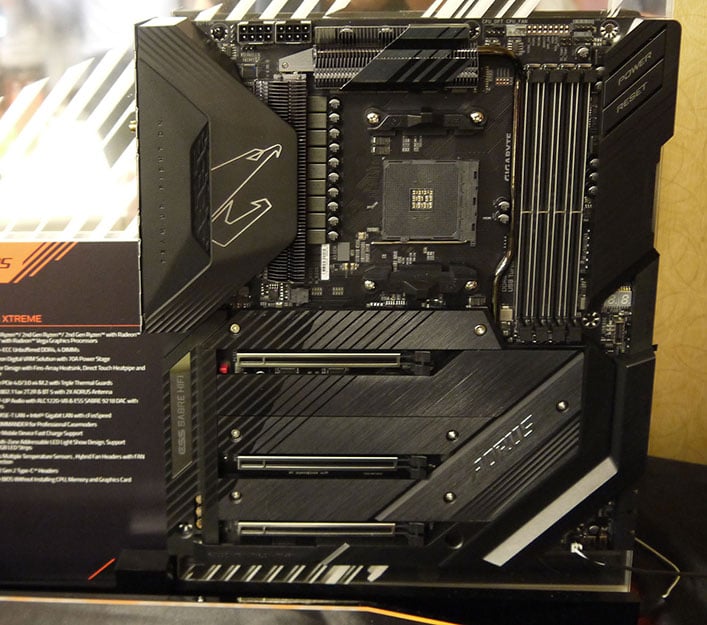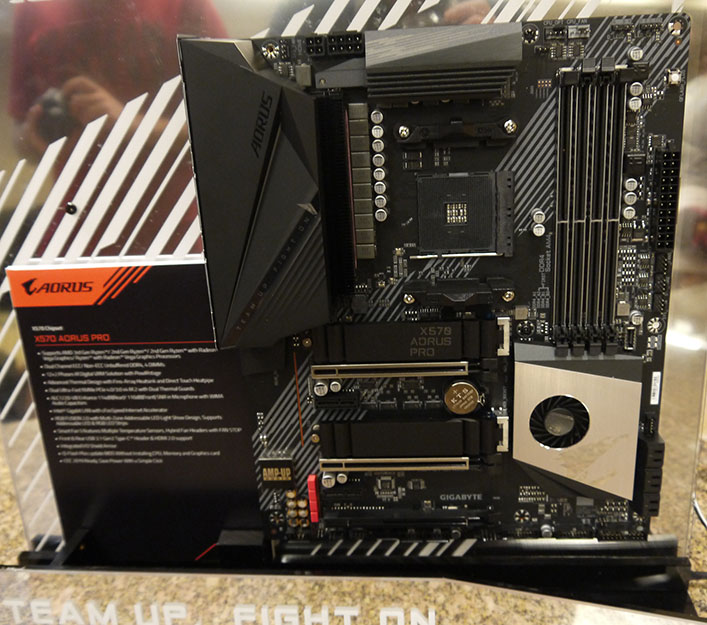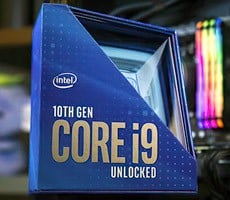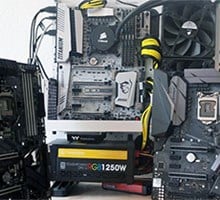Gigabyte Aorus X570 Motherboard And PCIe 4.0 SSD Preview: Ready To Rock Ryzen 3000
Aorus X570 Motherboards, Gen 4 SSDs, and Gaming Displays
To say the just-released AMD Ryzen 3000 series processors and Radeon RX 5700 series graphics cards are game-changers for AMD (and PC enthusiasts) would be an understatement. The Zen 2-based Ryzen 3000 series processors aggressively take on Intel's competitive offerings in virtually every metric and offer features, like PCI Express 4.0, not yet available on other platforms. PCI Express 4.0 means more bandwidth for components like graphics cards and solid state storage, and more bandwidth can translate to fewer bottlenecks and increased performance, especially for storage.
AMD's latest offerings have OEM partners like Gigabyte excited and lining-up to support the platform. Gigabyte has an extensive array of motherboards, graphics cards, storage devices, and other accessories at the ready to support the Ryzen 3000 series and Radeon RX 5700 family of graphics cards.
At a recent event, Gigabyte featured its top-flight Aorus motherboards for Ryzen 3000, but the company also had some gaming monitors and PCI 4.0 SSDs on hand. The motherboards were all based on AMD's X570 chipset, but had varying feature sets, depending on the target market and price point.
The X570 chipset for the Ryzen 3000 series is designed to properly support all of the new processors' leading edge features. The most obvious is the X570's support for PCI Express 4.0, which allows Radeon RX 5700 series graphics cards and the first PCIe 4.0 NVMe solid state drives to run natively at full Gen 4 speeds. Sure, previous-gen X470 motherboards support the latest Ryzen processors as well, but they're not PCIe 4.0 capable.
The X570 Aorus Xtreme
In total Gigabyte is launching six new Aorus-branded motherboards based on the X570 chipset. The top model is the X570 Aorus Xtreme. As the top dog in the line-up, the X570 Aorus Extreme motherboard comes loaded with a wide array of features, the most noticeable of which is the massive cooling apparatus that covers nearly 85% of the PCB's surface. There are very few motherboards on the market with such an extensive array of heat-sinks, heat-pipes, and heat-spreaders pre-installed, so Gigabyte is confident in this motherboard’s ability to remain cool under the heaviest of workloads.
Gigabyte has also bulked up the VRM on its new line-up of X570 motherboards. Most previous-gen Aorus motherboards used what Gigabyte called “True Phase” technology, which essentially spreads the load being placed on the VRM across the various phases and doublers incorporated into the circuitry. The X570 Xtreme board takes a different approach, however. It uses a direct, 16-phase all digital VRM with no doublers. Instead it has a microcontroller that interfaces directly with all 16 phases and spreads the load evenly to improve efficiency. According to Gigabyte, the new setup results in an approximate 4% improvement in efficiency, which increases longevity, reduces temperatures and balances the overall amount of power being used. Four percent might not sound like a lot, but to put it in perspective, in the power supply industry, 4% can be the difference between a gold and silver rating.
The X570 Aorus Xtreme edition motherboard also comes with features that overclockers will find helpful, such as the on-board power buttons, LED diagnostics, voltage check-points, and dual 8-pin CPU power connectors. Gigabyte has also completely revamped the BIOS on its Aorus boards, with input from prominent overclockers. The result was a leaner BIOS interface with all of the most important settings clearly visible and easily accessible.
The X570 Aorus Ultra
The X570 Aorus Master and X570 Aorus Ultra boards are positioned just below the X570 Aorus Xtreme. Both of these motherboards are similar, but the Master is designed for more advanced users and hardcore overclockers that plan to squeeze every last drop of performance out of their new Ryzen processors. Gigabyte uses the same direct 16 phase VRM as the Extreme motherboard on the X570 Aorus Master, in addition to voltage check-points, a nano carbon base plate, and dual 8-pin CPU power connectors. The Ultra model ditches these features that may not be fully leveraged by some users, but it's also lower priced as a result.
The X570 Aorus Pro WIFI
The X570 Aorus Pro WIFI motherboard tries to hit the "sweet spot" in the PC enthusiast market. This board nixes some of the bells-and-whistles of the more expensive X570 Aorus motherboards, but it still has plenty of high-end features, a robust cooling solution, and easy overclocking tools for 3rd Gen Ryzen processors.
Aorus X570 I Pro WIFI
As the "I" in its model number suggests, the Aorus X570 I Pro Wifi is the smallest motherboard in the line-up, but what it lacks in size it makes up for in features. This pint sized, mini-ITX motherboard comes with two large heatsinks on the VRM, as well as the chipset. Like most of the motherboards we were shown, the chipset on this board requires active cooling. This is due to the X570 drawing considerably more power than the previous-gen X470 -- you can read our article about that right here. The board also has a single PCIe 4.0 slot, dual M.2 connectors, and a direct 8 phase digital VRM.
As we stated earlier, Gigabyte has revamped the BIOS interface with its latest Aorus X570-based motherboards. The new interface was designed with input from overclockers and enthusiasts, so it should be easier to navigate. Some of the new features include a "My Favorites" option where users can put the most used options in one spot. Gigabyte is also trying to improve the user experience by putting the most commonly used options front and center. We haven't spent much real-world, hands-on time with it yet, so we can't make a determination either way just yet, but the redesign does show promise.
Along with the new BIOS, Gigabyte is also introducing some new "Noise Detection" technology. Noise Detection, does exactly what it sounds like. It gauges the noise the fans are making and adjusts their speeds accordingly. All you have to do is set the desired decibel level and the motherboard will do the rest.
The Aorus PCIe Gen 4 NVMe SSD
Lane for lane, PCI Express 4.0 provides doubles the bandwidth of PCIe 3.0, while maintaining backward compatibility. The additional bandwidth means we are going to see some blistering fast storage solutions hitting the market soon. Gigabyte actually had a wild, 4 x RAID PCIe 4.0 NVMe SSD on hand using ultra fast Toshiba flash memory, that was able to hit >15GB/s reads and writes.
Aorus NVMe Gen 4 SSD
Gigabyte also had its standard also Aorus PCIe 4.0 NVMe M.2 SSD on hand. This SSD sports the latest Toshiba BiCS4 flash memory and includes a large copper heatsink. The heatsink will help keep the memory and on-board Phison controller running nice and cool, but it can be easily removed if spacing is an issue. The NVMe SSD comes in either 1TB or 2TB capacities and has read and write speeds of 5000MB/s and 4400MB/s, respectively.
Aorus Tactical Monitors
Last, but not least, Gigabyte had its new Aorus tactical gaming monitors on display. The monitors feature a curved Samsung FHD (1080p) panel with a 240Hz refresh rate and a 0.5ms response time. With the response time being under a millisecond on-screen images remain nice and sharp, regardless of how fast the images on the screen are moving. We were able to test the monitors first hand, and they were impressive.
All told, Gigabyte has a wealth of new gear lined-up for gamers and PC enthusiasts, underpinned primarily by the innovations of AMD's 3rd Gen Ryzen processor platform. We look forward to digging into some of these interesting new offerings here at Hot Hardware, in deep dive reviews in the weeks ahead.
















